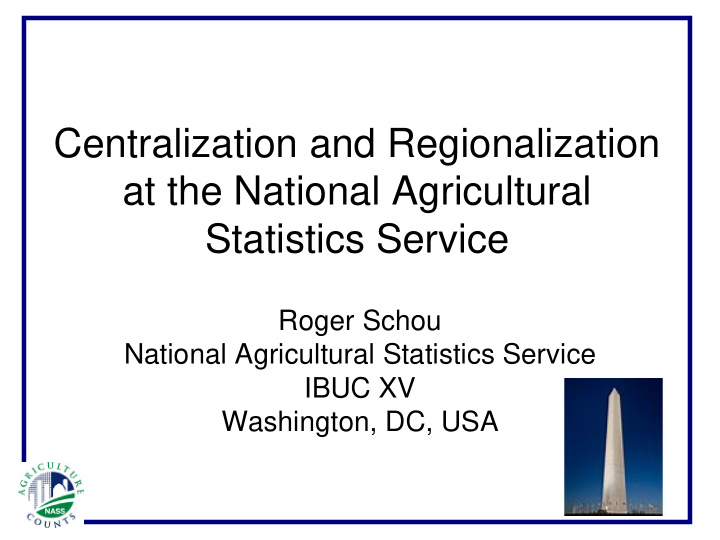



Centralization and Regionalization at the National Agricultural Statistics Service Roger Schou National Agricultural Statistics Service IBUC XV Washington, DC, USA
Centralized Surveys • IBUC XIII – 1 survey – Mink (April 2010) • IBUC XIV – Approximately 25 surveys • Currently – Approximately 55 surveys • Weekly, bi-weekly, monthly, semi-annual, annual, and pentennial
Blaise Data Storage at NASS • MySQL Database – All surveys in one set of tables • Generic In-Depth Storage – Allows for one ETL (Extract, Transfer, Load) program to copy necessary data from transactional MySQL database to the analyticl Redbrick database – Eight Blaise tables • A few additional NASS-specific tables
System Flow Blaise Citrix Server Application/Data Tables Server (DEP & Manipula Blaise Services Running MySQL executables) Instruments & BOI files Transactional Activity ETL (Edit,Transfer,Load) WIP Analysis & Summary RedBrick Applications Analytical Activity
Generic In-Depth Tables • BLAISE_DICTIONARY • BLAISE_ID • BLAISE_CASE • BLAISE_FORM • BLAISE_KEY • BLAISE_DATA • BLAISE_REMARK • BLAISE_OPEN
BLAISE_DICTIONARY • Catalog of all the surveys – Each instance of a survey has a unique DMKEY (data model key) • Each time a data model changes, a new DMKEY is assigned • Can be as minimal as a data model name • We use the survey’s folder name as the data model name, so we programmatically change it for weekly and monthly surveys • External sections are created on the fly and referenced via INCLUDES in the data model code
BLAISE_ID • Contains all block names and field names – All metadata about the block/field • Including FieldTag, DescriptionText, & ArrayIndex • NASS Cameleon scripts that created item code related files have been replaced by VB.NET code utilizing the Blaise API • Table is not used much by the Blaise system, but it’s a critical table for NASS
Item Codes and Varnames • NASS developed “hash notation” for item codes and varnames for repeated blocks – Example 1 in the paper illustrates hash notation (page 310) • Arrays with item code and varname coded within the block. – Item code mapping file gets a special coding pattern to insure the correct element is used – Varname has Table_Row number appended
BLAISE_CASE • Contains the unique JOINKEY and PRIMARY KEY for each record in the survey
BLAISE_KEY • Contains all of the Primary and Secondary Keys as defined in an instrument • BeginStamp is part of the key for this table which is needed if versioning is active
BLAISE_FORM • Contains the status information for each form – Form status – Error count – Remark count – Don’t Know count – Refusal count
BLAISE_DATA • Contains the data for the records in the survey
BLAISE_REMARK • Contains the remarks left on fields for a survey
BLAISE_OPEN • Contains the answers to any OPEN type fields
NASS CASIC Tables • CASIC_SURVEYINFO • CASIC_FAT • CASIC_MANAGEMENT • CASIC_EVENT_LOG
CASIC_SURVEYINFO • Survey-level information – Instrument Name – Folder Name – BOI File Name – Assorted indicators – Some Start and End Dates • Menu system makes extensive use of this table
CASIC_FAT • Used to control access • Identifies: – State to whom the record belongs – Data Collection Center (DCC) Assigned – Estimation Center (EC) Assigned – Region to which the state belongs – Region to which the DCC belongs – Region to which the EC belongs
CASIC_MANAGEMENT • Update to the paper: – Key of the CASIC_MANAGEMENT table is now: DMKEY, JOINKEY, BEGINSTAMP • Contains several fields that appear in nearly all of our instrument • Table is indexed on these fields to increase the performance of instruments • Allows record filters to be more efficient
CASIC_MANAGEMENT • June Area instrument is exception to NASS “standard” fields • Similar fields, but different blocks – Table was not populated by our system – Performance ground to a halt • Complicated instrument • No indexes utilized • An extremely large external file
CASIC_EVENT_LOG • Used as a debugging tool • Tracks the activity on the CASIC Menu • Every button click registers a “BEGIN” • When process finishes, registers an “END” • We can detect what processes are running, who is running them, and how long they are running
Centralized Blaise Concept • All data in one central location • All surveys look the same in the database – Only one ETL needed to copy data • Records logically separated using record filters • Dynamic menu reacts to user’s location and role
NASS Infrastructure Eastern Citrix Blaise MySQL LAN LAN Workstation Data Server (1 ms latency) (1 ms latency) Western Citrix Blaise MySQL WAN LAN Workstation Data Server (30 ms latency) (1 ms latency) LAN = Local Area Network WAN = Wide Area Network
Future NASS Infrastructure Eastern & Western Citrix Blaise MySQL LAN LAN Workstation Data Server (1 ms latency) (1 ms latency) Citrix Server, Blaise Data Server, and MySQL Database all located in Kansas City LAN = Local Area Network
Hybrid Surveys • Temporary Workaround – For high profile, quick turnaround surveys where 1 missed night of calling is not acceptable • CATI data collection is done in a decentralized (local) Blaise data set, then sent to the Central MySQL Blaise data set via Manipula – Remaining processes done centrally • Currently being phased out
REGIONALIZATION • Moved from 46 state field offices to 12 regional offices – Nearly complete • New set of record filters now group by region • CASIC System works regionally whether you are sitting in the Regional Field Office or in one of the states within a region
Other Centralization • Other NASS systems undergoing centralization efforts – Survey Management System – Tracking and Control – Enumerator Skills Database • Centralizing commonly used tables – County lookup/validation • Inter-database communication – Blaise API
Conclusion • Streamlining Processes – Centralization – Regionalization – Colocation of Servers • Do more with less • Future of Blaise at NASS – Only CATI software – One of two edit systems (after sunsetting legacy system)
Questions
Recommend
More recommend